Will 2024 be very hot? Should we be worried?
post by A.H. (AlfredHarwood) · 2023-12-29T11:22:50.200Z · LW · GW · 12 commentsContents
El Niño
What is El Niño?
How does it affect global temperatures?
What about second-order effects?
Are we currently in an El Niño phase?
How long will it last?
Is this one going to be bad?
Solar Cycles
What is the solar cycle?
How does it affect global temperatures?
When will the current solar cycle peak?
The Hunga-Tonga Eruption
How does this cause warming?
How much warming will this cause?
What are the timelines?
Reduced Sulfates from Marine Fuel Emissions
What has happened?
How will this affect global temperatures?
What does this add up to?
How bad could it be?
Shifting the Tails
What should be done?
Conclusion
None
12 comments
tl;dr: There are several trends which suggest that global temperatures over the next year will experience a short-term increase, relative to the long-term increase in temperatures caused by man-made global warming.
Credits: Most of the information comes from Berkley Earth monthly temperature updates. Several people on Twitter (Robert Rohde, Zeke Hausfather, James Hansen and Roko) have also been talking about the issues discussed here for a while.
Man-made global warming has been causing a steady, long-term increase in average global temperatures since the industrial revolution. However, recently several trends are lining up which suggest that the next year/few years might experience temporary greater-than-average warming, on top of baseline man-made warming. Some of these factors are already in play and 2023 is 'virtually certain' to be the hottest year on record.
The story can be summed up in this lovely graphic from Berkley earth:
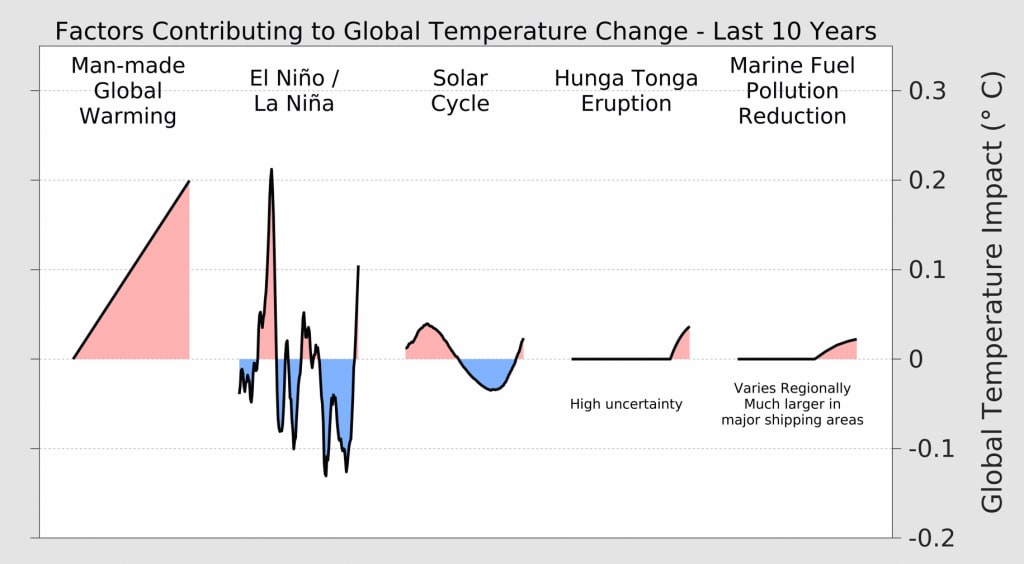
I've had a look into some of the things that are happening and have written up what I've learned. I am not a climate scientist, so take this all with a pinch of salt.
El Niño
What is El Niño?
Periodically, the strength and direction of the winds over the Pacific ocean changes, causing the surface waters to flow differently, which leads to changes in the amount of cold water coming up from the depths of the ocean. This pattern is known as the El Niño–Southern Oscillation. The phase when the surface waters are warmer is known as El Niño, and the phase when the surface waters are cooler is known as La Niña.
These periods occur irregularly every few years and last approximately a year.
How does it affect global temperatures?
Unsurprisingly, during the El Niño period, when surface waters are warmer, more heat is released into the atmosphere, leading to warmer global surface temperatures. In general, years with El Niño are hotter and years with La Niña are cooler on average. This is a pretty reliable generalisation but is not a totally hard-and-fast rule as shown in the figure below[1].

However, like a lot phenomena in climate science, El Niño has different effects depending on what part of the world you are in. Broadly, areas in the southern hemisphere and areas by the coast experience more warming than others. But El Niño can actually cause cooling in some areas, so its important to check where you live.
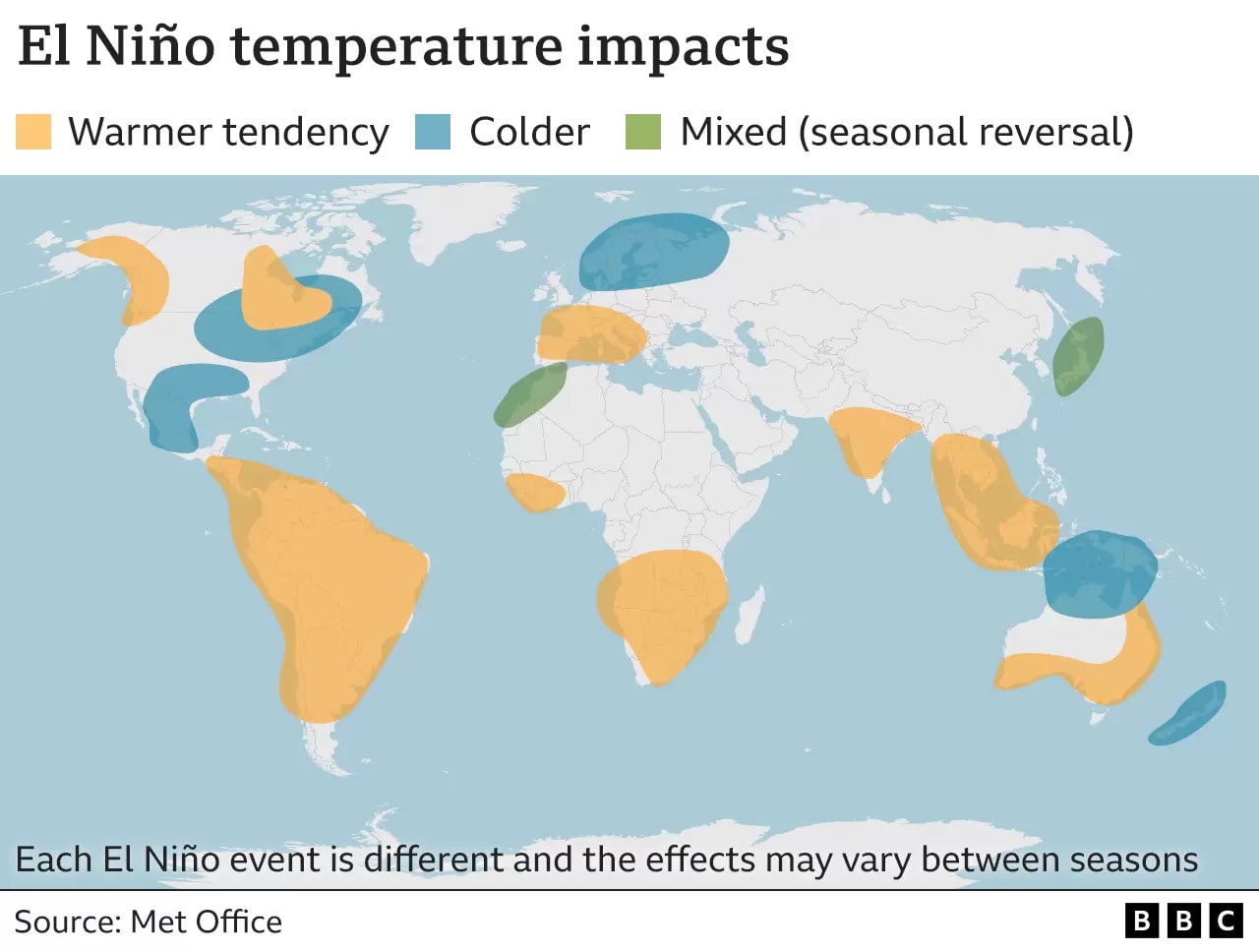
When averaged out over the globe, global surface temperature during El Niño years is about 0.1-0.2C higher than normal.
What about second-order effects?
This change in temperature can cause all kinds of other effects such as flooding, drought, disease and crop failures, on top of the direct effects of heat.
Are we currently in an El Niño phase?
Yes, it started in early summer this year.
How long will it last?
It is expected to last until (Northern Hemisphere) summer 2024 and expected to peak around (Northern Hemisphere) winter (ie. soon). However, (quoting Berkley Earth) again:
'Due to the lag between the development of El Niño and its full impact being felt on global temperatures, it is plausible that the current El Niño will have a greater impact on global temperatures in 2024 than it does in 2023.'
So it is not over yet. Even though it will peak during Northern Hemisphere winter, its effects will still be felt into the summer, on top of normal seasonal temperature increases.
Is this one going to be bad?
The current El Niño phase is shaping up to be the one of the strongest ever.
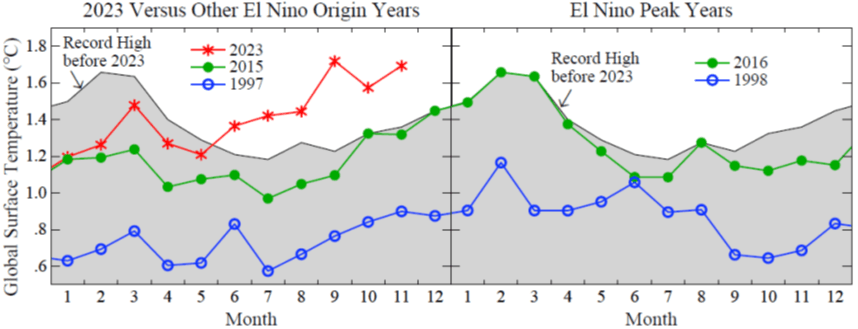
However, one thing I don't understand: is this just because of 'standard' increases from man-made warming or is it something about the winds/ocean currents which makes this one strong?
Solar Cycles
What is the solar cycle?
Approximately every 11 years, for reasons I don't understand, the magnetic field of the sun flips. In the time period surrounding this flip, the solar activity (in the form of sunspots and irradiance) increases.
How does it affect global temperatures?
Presumably, an increase in irradiance from the sun causes an increase in global temperatures, but I've found it hard to get numbers on this. I'm looking for things in laymans units like 'during a peak of solar activity, global atmospheric temperatures are x C higher than average' but I can't find this. All I can find are articles like this (presumably aimed at climate change sceptics) arguing against the view that all global warming can be explained by solar activity. I believe you, NASA, just tell be how much warming can be attributed to solar activity! You can trust me with this information! I promise I won't use it to spread climate change scepticism...
The best I can do is eyeball the graph from Berkley Earth shown in the introduction. This indicates an increase of 0.04C above average at the peak of solar activity.
When will the current solar cycle peak?
The current solar cycle will probably peak in 2024 between January and October. The peak is expected to be stronger than was previously predicted.
The Hunga-Tonga Eruption
Between December 2021 and January 2022 the wonderfully-named Hunga Tonga–Hunga Haʻapai volcano erupted. It was the largest eruption since Mount Pinatubo and the most powerful since Krakatoa in 1883. Call me ignorant but I had no idea this happened.
How does this cause warming?
You may have heard that volcanic eruptions can cause cooling of earth's temperatures. This is true. Volcanic eruptions emit large quantities of sulphur dioxide, which react with water vapour in the atmosphere to create sulphuric acid which reflects solar radiation. (You may have heard about geoengineering proposals to introduce more sulphur dioxide into the atmosphere to reduce the effects of global warming).
However, the Hunga Tonga–Hunga Haʻapai volcano was under the ocean's surface when it erupted, causing it to inject millions of tonnes of water vapour into the atmosphere. Water vapour is a strong greenhouse gas, so this causes warming. See here for a more detailed explanation.
How much warming will this cause?
Robert Rohde (of Berkley Earth) points to this paper (no-paywall pdf version here) which suggests that the overall warming from the eruption is about 0.035C, but this is tentative and it is important to emphasise that there is a lot of uncertainty in this estimate.
What are the timelines?
The eruption is no longer ongoing. The water vapour was injected into the atmosphere over a couple of months, in late 2021/early 2022 and is mostly still there.
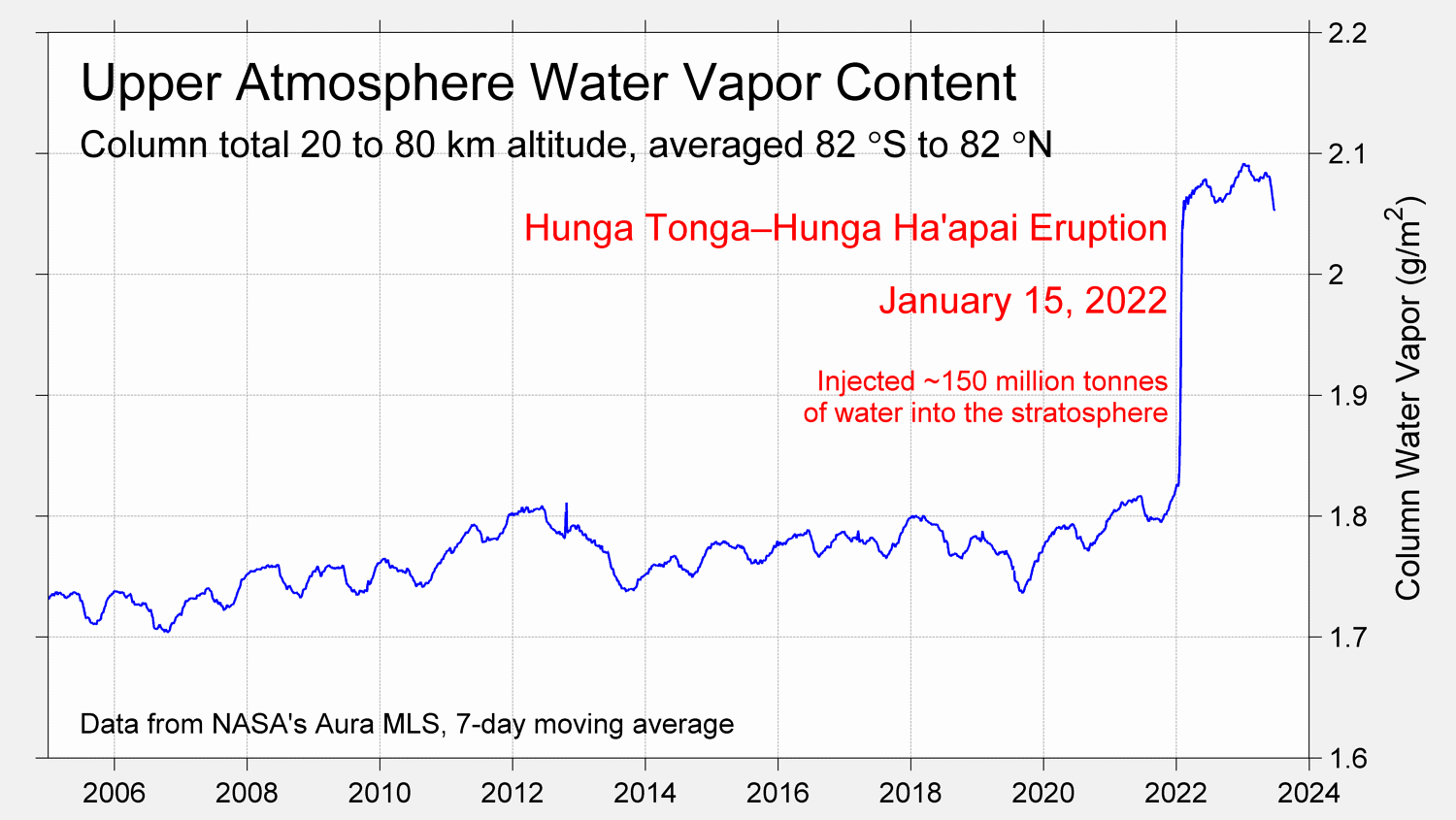
The extra atmospheric water vapour probably isn't going anywhere soon. This NPR article claims that the water will take 5-10 years to dissipate.
It is likely that this is already affecting the temperature. So as a crude estimate, we can expect temperatures to be 0.035C higher than normal for the next ~5 years.
Reduced Sulfates from Marine Fuel Emissions
What has happened?
Many fossil fuels, when burned, release sulphur dioxide which (as noted earlier) can cause cooling. Since sulphur dioxide can be harmful to humans, many countries have legal limits on the amount of sulphur allowed in fuels. In 2020, the International Maritime Organisation (IMO) introduced regulations which reduced the legal upper limit of sulphur allowed in fuel oil for ships from 3.5% to 0.5%.
In terms of reducing SO2 emissions, this was really successful!
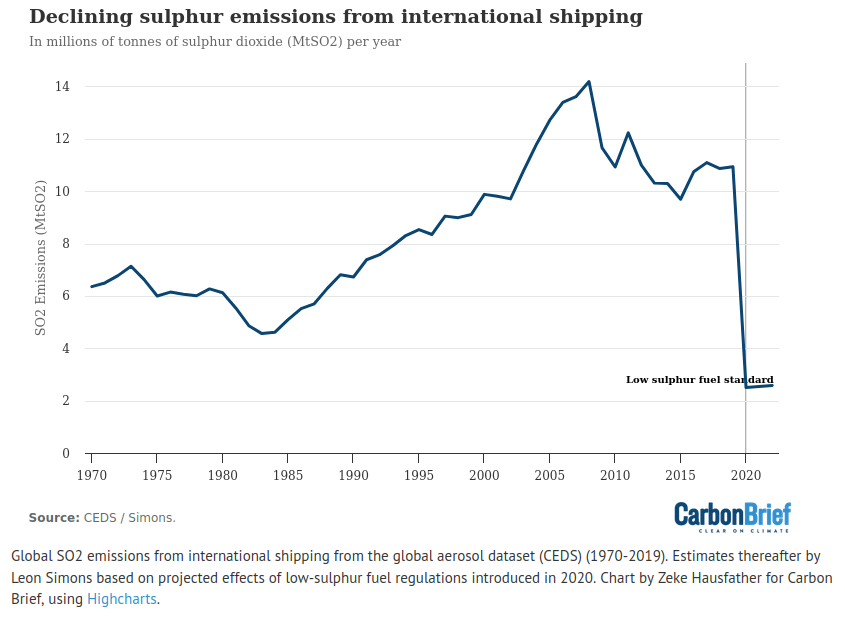
Shipping is not the only source of SO2 emissions, but this still resulted in the overall reduction of global SO2 emissions by around 10%.
How will this affect global temperatures?
The full effect of reducing SO2 emssions on global temperatures is not instantaneous. CarbonBrief estimates that, over 30 years, this will contribute to 0.045C of warming, with half of that happening in the first four years (the first four years after the reduction in emissions, that is, the first four years after 2020). Another analysis, cited by CarbonBrief and conducted before the recent regulations, gives similar estimates. This suggests that 2024 will be ~0.02C warmer than average.
This estimate concerns average global temperature. However, predictably, the effects are not evenly spread throughout the world. Areas with heavy shipping like the North Pacific and North Atlantic regions will probably be most affected. It is estimated that (as of June 2023) the North Atlantic had already experienced 0.2 °C of warming due to changes in sulphur emissions (though this concerns ocean temperature, not atmospheric temperature). See here for more discussion of this estimate, which, it should be emphasised, is tentative.
What does this add up to?
Here are each of the global average temperature change contributions which might apply next year, compared to a hypothetical pre-2020 fuel regulation, pre Hunga-Tonga eruption, non-El Niño year.
- El Niño: +0.2C
- Solar Cycle peaking: +0.04C
- Hunga-Tonga: +0.03C
- SO2 fuel reduction: +0.02C
Disclaimers before continuing:
- There is no perfect 'baseline' year to use as a reference point. The El Niño Southern Oscillation and solar cycles have been happening since before records began. Volcanoes are always erupting and humans have been changing the climate since we learned how to cut down trees.
- These numbers are estimates, not infallible prophecies. Prediction is hard, especially about the future. The Hunga-Tonga estimate is especially uncertain.
- These numbers represent global averages, and most of them have more extreme regional effects. El Niño's regional effects are quite varied depending on your location and SO2 reduction is expected to cause the most warming in the North Atlantic and North Pacific
- The effects will peak at different times in the year. El Niño will probably peak early in 2024, solar cycles will peak at some point in the first 10 months of 2024, and SO2 contributions to warming will steadily increase over the year.
- The climate is complex and these effects will likely all interact in subtle, unforeseen ways.
- Whatever you do, you shouldn't just add up all of the numbers and use that to form an estimate of temperature increase next year.
Having made these disclaimers, I'm now going to add up all of the numbers use that to form an estimate of temperature increase next year. Stop reading now if that will disturb you.
0.2+0.04+0.03+0.02 =0.29C
For context, the man-made warming from carbon emissions over the last ten years has been approximately +0.2C.
At this point, I should emphasise that El Niño makes by far the largest contribution to temperature increase. In some ways, this is good news, as humanity has ~successfully been muddling its way through El Niños for centuries. Also, El Niño has already been happening this year, so 2024 might not represent a significant increase compared to 2023. There is a lot of uncertainty in all of the estimates: they could easily go up or down significantly.
How bad could it be?
The 1997-1998 El Nino provides one reference point. It was particularly strong, causing warming exceeding 0.2C [2]. This was bad. It caused drought followed by extreme rain, leading to outbreaks of Rift Valley Fever, which were particularly bad in Kenya and Somalia. It also lead to large areas of coral reef dying off and tens of billions of dollars of economic losses.
But it wasn't insurmountably bad. Humanity survived. Be honest: if, before you read this you were asked 'what was the worst thing about 1998', would you have said 'El Nino'? Again, feel free to call me ignorant, but I had no idea that this happened.
As usual, extreme weather hits developing countries worst. I'm struggling to find numbers for the 1997-1998 Rift Valley Fever outbreaks in Africa, but it seems like in Kenya the death toll was in the hundreds, out of tens of thousands of infections. This is terrible. But it is still less than the number of malaria deaths that occurs in Kenya each year, El Niño or not. In fact, many of the diseases which El Niño increases, such as Dengue, Rift Valley Fever (and malaria) are increased because of flooding, leading to standing water which acts as a breeding ground for mosquitoes, which spread the diseases. So policies which prevent malaria, like using bednets and removing standing water are presumably good for mitigating El Niño-related disease increases.
To be clear: I am not minimizing the effects of temperature increase on developing countries. It will be bad. Its just that, if you are a developing country, it is possible for you to have problems that are bigger, more immediate, and more tractable than temperature increases. As usual, helping these countries develop often helps solve multiple problems at once and also increases resilience against the effects of climate change.
Shifting the Tails
Many climate activists often emphasise, that the main problem with climate change isn't the temperature increase per se; its the fact that the shift in average temperature can lead to a greater range of weather events and increases the risk of extreme events. An increase of temperature of 0.2C doesn't mean that every day will just be 0.2C warmer. It means that a lot of days will be about average, but some days will be a lot warmer, some places will experience dry periods which are much longer, some places will experience rainy seasons which are much wetter. It is the increase in these tail risks which poses the biggest threat from global warming, both long-term and the temporary increase we might see next year.
What should be done?
Global temperatures are increasing by about 0.2C per decade. We might experience a comparable increase on top of this in 2024, due to the factors mentioned above. As a result, a lot of the standard responses to climate change which are already being pursued will be helpful here, albeit it over a shorter timeframe. Things like improved water storage and flood defences will be helpful, but probably are not feasible for countries to improve over the next few months. Also, since El Niño started this year, a lot of preparations are already in place. The WHO was preparing for El Niño-related disease outbreaks back in June.
An easier target is air conditioning (AC)[3]. It is easier to install an air conditioner in a few months than it is to build a reservoir. At the moment there are many marginal countries where air conditioning is not common because summers do not often reach the temperatures which make them worthwhile. Historically, in these countries the costs of buying/installing an AC unit has outweighed the benefits, but at some point, increasing temperatures will mean that buying AC becomes favourable. The factors coalescing next year may mean that for some countries, 2024 is the year this happens.
For example, I live in a developing country called the UK where, to the constant surprise of the US Media outlets, most buildings do not have AC. As of 2021, less that 5% of homes had AC. Given the repeated heat waves we have experienced over the last few years, I imagine these numbers have gone up, but in my experience, the majority of houses still have no AC. This generally hasn't been a problem, until the last couple of years, when the summer heatwaves caused discomfort for a lot of people and a fair number of excess deaths. Since these heatwaves aren't going away any time soon and will likely get worse in 2024, there are probably many marginal households in the UK where investing in AC becomes worthwhile this year.
Governments in these marginal countries without AC might also want to consider investing in AC for elderly people, who tend to die in heatwaves. During the 2022 heatwaves in the UK, there were 2,985 excess deaths, of which 2,839 (95%) were of people aged over 65. In Spain, air conditioning was found to reduce excess deaths from extreme heat by about 30%. Ensuring all nursing homes for the elderly have AC seems like an easy win here, but I can't find any data on whether they already do. I haven't been in any nursing homes, but I have worked as a domestic careworker for elderly people and I can confirm that zero percent of the houses I visited had air conditioning (including semi-independent sheltered accommodation).
Conclusion
2024 will probably be hot. It might be significantly hotter than previous years. The risk that this poses to you depends strongly on where you live and how much you and your government have invested in prevent the worst effects. People living closer to the coast and southern hemisphere will experience the brunt of the effects of El Niño. Those living in the North Atlantic and North Pacific will experience the brunt of the effect of the SO2 reduction from shipping. If you live in one of these areas (or an area which falls into both of these categories), you might want to make some preparations for a hot year. If you are the government of one of these countries and there are quick precautions you can take against flooding, drought and mosquito-spread diseases, they might be worthwhile, especially if you are developed and don't have more immediate priorities. If you live in a developed country which is not in one of the worst-affected areas but you have noticed summers getting uncomfortably hot over the last few years, take this as a sign that things will probably be getting worse before getting better (if they ever get better). If you are well off and feel like you are on the verge of investing in AC (or other cooling methods for your house), it might be wise to do it now, before the inevitable surge in demand which will accompany summer heatwaves. If you are the government of a developed country with money to invest in the welfare of the elderly, it may be beneficial to invest in (or subsidise) air conditioning for nursing homes and elderly people living in their own homes.
- ^
Figure from Wikipedia. Attribution: By RCraig09 - Own work, CC BY-SA 4.0, https://commons.wikimedia.org/w/index.php?curid=109388602
- ^
Wikipedia claims that warming temporarily exceeded 1.5C and cites this paper as evidence. However, after a quick skim I can't actually find that claim in the paper, nor can I identify how 'temporarily' the temperature was increased.
- ^
I just talk about AC, but this discussion obviously also applies to any other ways of cooling buildings, like passive cooling techniques.
12 comments
Comments sorted by top scores.
comment by SarahNibs (GuySrinivasan) · 2023-12-29T20:35:17.644Z · LW(p) · GW(p)
Be honest: if, before you read this you were asked 'what was the worst thing about 1998', would you have said 'El Nino'?
The only thing I associate with the year 1998, when I was 15 years old and living in Florida, is the phrase "the fires of '98", referring to a particularly severe fire season, with memories of driving across interstate highways with limited visibility due to smoke.
I just Googled it and it has a Wikipedia page apparently: https://en.wikipedia.org/wiki/1998_Florida_wildfires
Replies from: AlfredHarwood↑ comment by A.H. (AlfredHarwood) · 2024-01-06T16:49:30.273Z · LW(p) · GW(p)
Interesting, thanks for sharing! I hadn't heard of this.
From Wikipedia:
An El Nino during the winter of 1998 produced above-average rainfall, which enabled extensive growth of underbrush and vegetation in the state's forests. In early April, however, the rains came to an abrupt halt, and the ensuing drought lasted until July.[2] These months of continuing dry conditions saw the drought index rise to 700 (out of 800), indicating wildfire potential similar to that usually found in western states.
I would assume that the drought was also exacerbated by El Nino, but its interesting that the main contributer is implied to be the rainfall in winter, rather than the heat the next summer.
Replies from: GuySrinivasan↑ comment by SarahNibs (GuySrinivasan) · 2024-01-06T19:10:50.016Z · LW(p) · GW(p)
Yeah climate change has two pretty consistent trends: average heat slowly rising, and variance of phenomena definitely higher. More extremes on a variety of axes.
comment by Robert Cousineau (robert-cousineau) · 2023-12-29T20:38:28.971Z · LW(p) · GW(p)
Market odds are currently at 54% that 2024 is hotter than 2023: https://manifold.markets/SteveRabin/will-the-average-global-temperature?r=Um9iZXJ0Q291c2luZWF1
I have some substantial limit orders +-8% if anyone strongly disagrees.
comment by Garrett Baker (D0TheMath) · 2023-12-29T16:33:55.375Z · LW(p) · GW(p)
However, the Hunga Tonga–Hunga Haʻapai volcano was under the ocean's surface when it erupted, causing it to inject millions of tonnes of water vapour into the atmosphere. Water vapour is a strong greenhouse gas, so this causes warming. See here for a more detailed explanation.
Not yearlong heating though. Added water vapor stays in the atmosphere for a measly 9 days. Not the 5 years claimed by NPR. I don’t know where that graph came from but it seems absurd. Not the 5 years claimed by NPR. Not sure how that graph was made but it seems absurd.
Edit: Asking the source of the graph, this seems like a reasonable explanation:
Yes. In the lower atmosphere, the process of rain/snow causes water vapor to cycle every few weeks.
In the upper atmosphere, above the tropopause, there is no more precipitation, and the tiny fraction of water vapor that does reach that high will linger for years.
From Dr. Robert Rohde on Twitter.
Replies from: gjm, D0TheMath↑ comment by gjm · 2023-12-29T17:12:49.583Z · LW(p) · GW(p)
Well, one possibility is (1) that the article got it terribly wrong. But to my ignorant eye there are at least two others. (2) Perhaps water vapour in the stratosphere stays around for much longer than water vapour in the troposphere. (And most water vapour is in the troposphere, so any sort of average figure will be dominated by that.) (3) Your link says that an average molecule of water stays in the atmosphere for 9 days, but that isn't the same as saying that a change in the amount of water will only persist for that long; maybe there is a constant exchange of water molecules that leaves amounts roughly unchanged, so that if you put 2.3 metric fucktons of extra water into the atmosphere then a month later there will still be 2.3 metric fucktons of excess water but the specific water molecules will be different.
Perhaps someone who knows some actual climatology can tell us how plausible 1,2,3 are.
Here's the paper I think everyone claiming years is referencing: https://agupubs.onlinelibrary.wiley.com/doi/full/10.1029/2022GL099381. That in turn references https://agupubs.onlinelibrary.wiley.com/doi/10.1029/97GL01289 for which I can see only the abstract, which says "tau=1.3 years". If tau has the usual meaning (time to decay by a factor of e) then 5 years would be roughly the time for a 20x decay; but there may be more details that make the "5-10 years" figure less misleading than that makes it sound (e.g., upper versus lower stratosphere -- the water vapour from the recent eruption went a long way up).
Replies from: D0TheMath↑ comment by Garrett Baker (D0TheMath) · 2023-12-29T17:16:14.465Z · LW(p) · GW(p)
I asked the source of the graph, and he said it was so long because it doesn’t rain in the troposphere. This seems a believable explanation. (though also, why doesn’t it rain?)
Replies from: simon, AlfredHarwood↑ comment by simon · 2023-12-29T17:50:25.340Z · LW(p) · GW(p)
(though also, why doesn’t it rain?)
Not sure if there's some other reason, but in the stratosphere you don't afaik* get big convective updrafts like there are in the troposphere, which I presume is due to the rate at which temperature declines with altitude getting smaller than the rate at which a rising air body will cool due to expansion.
*Actually I think that this property is basically what defines the stratosphere vs the troposphere?
↑ comment by A.H. (AlfredHarwood) · 2023-12-29T17:46:12.898Z · LW(p) · GW(p)
Yeah, thanks for highlighting this. I started writing about it but realised I was out of my depth (even further out of my depth than for the rest of the post!) so I scrapped it.
Thanks for clarifying with Robert Rohde!
I reached roughly the conclusion you did. When water vapour is injected into the troposphere (the lowest level of the atmosphere) it is quickly rained out, as you point out. However, the power of the Hunga-Tonga explosion meant that the water vapour was injected much higher, into the stratosphere (what the diagram calls the 'upper atmosphere'). For some reason, water vapour in the stratosphere doesn't move back down and get rained out as easily so it sits there. Which is why 'upper atmosphere' water vapour levels are still elevated almost two years after the explosion.
↑ comment by Garrett Baker (D0TheMath) · 2023-12-29T16:41:26.980Z · LW(p) · GW(p)
Though also there may be complications from it being higher up than water vapor usually goes.
comment by Daniel Kokotajlo (daniel-kokotajlo) · 2023-12-30T02:34:07.499Z · LW(p) · GW(p)
lovely graphic
Very lovely! Eyeballing it, doesn't it imply that while 2024 will be hotter than 2023, the difference between 2024 and 2023 will be smaller than the difference between 2023 and 2022? Because the slope of the various lines is decreasing and in no case increasing?
Or is the y-axis measuring YoY impact rather than impact-relative-to-some-fixed-beginning? If so then I'm confused why the global warming section looks the way it does.
↑ comment by A.H. (AlfredHarwood) · 2023-12-30T11:05:01.884Z · LW(p) · GW(p)
Eyeballing it, doesn't it imply that while 2024 will be hotter than 2023, the difference between 2024 and 2023 will be smaller than the difference between 2023 and 2022? Because the slope of the various lines is decreasing and in no case increasing?
Yeah, that sounds right I think.
Or is the y-axis measuring YoY impact rather than impact-relative-to-some-fixed-beginning? If so then I'm confused why the global warming section looks the way it does.
I agree, I don't think that YoY interpretation makes sense. I realise now that it's not made completely clear but I think its impact relative to some past value. That's the only way that that I can make sense of the man-made global warming section being a straight line.